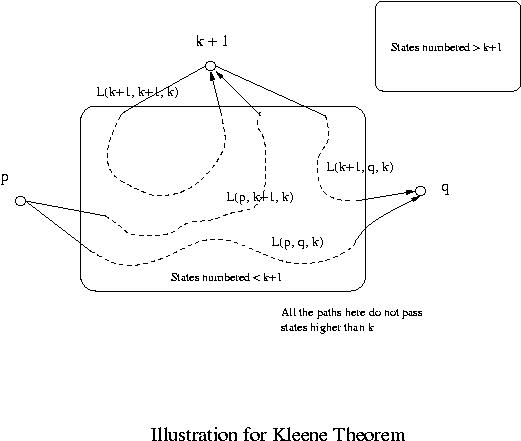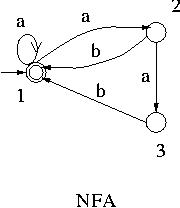Finite Automata
Kleene's Theorem -- Part 2
Subjects to be Learned
- Languages accepted by FAs are regular
Contents
The converse of the part 1 of Kleene Theorem also holds true. It states that any language accepted by a finite automaton is regular.
Before proceeding to a proof outline for the converse, let us study a method to compute the set of strings accepted by a finite automaton.
Given a finite automaton, first relabel its states with the integers 1 through n, where n is the number of states of the finite automaton. Next denote by L(p, q, k) the set of strings representing paths from state p to state q that go through only states numbered no higher than k. Note that paths may go through arcs and vertices any number of times.
Then the following lemmas hold.
Lemma 1:
L(p, q, k+1) = L(p, q, k)  L(p, k+1, k)L(k+1, k+1, k)*L(k+1, q, k) .
L(p, k+1, k)L(k+1, k+1, k)*L(k+1, q, k) .
What this lemma says is that the set of strings representing paths from p to q
passing through states labeled with k+1 or lower numbers consists of the following two sets:
1. L(p, q, k) : The set of strings representing paths from p to q passing through states labeled wiht k or lower numbers.
2. L(p, k+1, k)L(k+1, k+1, k)*L(k+1, q, k) : The set of strings going first from p to k+1, then from k+1 to k+1 any number of times, then from k+1 to q, all without passing through states labeled higher than k.
See the figure below for the illustration.

Lemma 2:
L(p, q, 0) is regular.
Proof:
L(p, q, 0) is the set of strings representing paths from p to q without passing any states
in between. Hence if p and q are different, then it consists of single symbols representing arcs
from p to q.
If p = q, then  is in it as well as the strings
representing any loops at p (they are all single symbols).
Since the number of symbols is finite and since any finite language is regular,
L(p, q, 0) is regular.
is in it as well as the strings
representing any loops at p (they are all single symbols).
Since the number of symbols is finite and since any finite language is regular,
L(p, q, 0) is regular.
>From Lemmas 1 and 2 by induction the following lemma holds.
Lemma 3:
L(p, q, k) is regular for any states p and q and any natural number k.
Since the language accepted by a finite automaton is the union of
L(q0, q, n) over all accepting states q, where n is the number of states of the finite automaton, we have the following converse of the part 1 of Kleene Theorem.
Theorem 2 (Part 2 of Kleene's Theorem):
Any language accepted by a finite automaton is regular.
Example :
Let us find the language accepted by the following finite automaton using the lemmas.

Let us denote by r(p, q, k) the regular expression for the set of strings L(p, q, k).
Then the language accepted by this NFA is r(1, 1, 3).
By Lemma 1, r(1, 1, 3) = r(1, 1, 2) + r(1, 3, 2)r(3, 3, 2)*r(3, 1, 2) .
r(1, 1, 2):
r(1, 1, 2) = r(1, 1, 1) + r(1, 2, 1)r(2, 2, 1)*r(2, 1, 1)
r(1, 1, 1) = r(1,1,0) + r(1,1,0)r(1,1,0)*r(1,1,0) = a* ,
since r(1,1,0) = a + .
.
r(1, 2, 1) = r(1,2,0) + r(1,1,0)r(1,1,0)*r(1,2,0) = a+ ,
since r(1,2,0) = a .
r(2, 2, 1) = r(2,2,0) + r(2,1,0)r(1,1,0)*r(1,2,0) = ba+
+ ,
since r(2,2,0) =
,
since r(2,2,0) =  and r(2,1,0) = b .
and r(2,1,0) = b .
r(2, 1, 1) = r(2,1,0) + r(2,1,0)r(1,1,0)*r(1,1,0) = ba* .
Hence r(1, 1, 2) = a* +
a+(b a+)*b a* .
r(1, 3, 2):
r(1, 3, 2) = r(1, 3, 1) + r(1, 2, 1)r(2, 2, 1)*r(2, 3, 1)
r(1, 3, 1) = 
r(2, 3, 1) = a
Hence r(1, 3, 2) = a+(b a+ +  )*a
)*a
= a+(b a+ )*a .
r(3, 3, 2):
r(3, 3, 2) = r(3, 3, 1) + r(3, 2, 1)r(2, 2, 1)*r(2, 3, 1)
r(3, 3, 1) = 
r(3, 2, 1) = r(3,2,0) + r(3,1,0)r(1,1,0)*r(1,2,0) = ba+ ,
since r(3,2,0) =  and
r(3,1,0) = b .
and
r(3,1,0) = b .
Hence r(3, 3, 2) =  +
ba+( ba+ +
+
ba+( ba+ +
 )*a
)*a
=  + ( ba+)+a
+ ( ba+)+a
r(3, 1, 2):
r(3, 1, 2) = r(3, 1, 1) + r(3, 2, 1)r(2, 2, 1)*r(2, 1, 1)
r(3, 1, 1) = r(3,1,0) + r(3,1,0)r(1,1,0)r(1,1,0) = ba*
Hence
r(3, 1, 2) = ba* + ba+( ba+ +
 )*ba*
)*ba*
= ( ba+ )*ba* .
Hence r(1, 1, 3) = a* +
a+(b a+)*ba* +
( a+( ba+ )*a )(  + ( ba+)+a )*( ba+ )*ba*.
+ ( ba+)+a )*( ba+ )*ba*.
This can be further simplified to (a + ab + abb)*, then to (a + ab)*.
The detail is left as an exercise though it would be quite challenging.
In this example there is only one accepting state. If there are more accepting states, then r(p, q, n) must be found for each accepting state q, where p is the initial state and n is the number of states in the given finite automaton, and all the r(p, q, n)'s must be added together to get
the regular expression for the language accepted by the automaton.
Test Your Understanding of Kleene's Theorem Part 2
Indicate which of the following statements are correct and which are not.
Click True or Fals , then Submit.
Next -- Complement and Intersection of Regular Language
Back to Study Schedule
Back to Table of Contents
 )*ba*
)*ba*
 + ( ba+)+a )*( ba+ )*ba*.
+ ( ba+)+a )*( ba+ )*ba*.
 L(p, k+1, k)L(k+1, k+1, k)*L(k+1, q, k) .
L(p, k+1, k)L(k+1, k+1, k)*L(k+1, q, k) .


